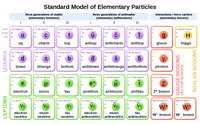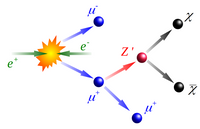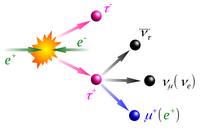The general idea of InterLeptons
The standard model of particle physics (SM) is a theoretical framework that describes fundamental interactions and constituents of matter. Although very successful in predicting phenomena, in recent years experiments worldwide have reported tensions arising from anomalies observed in the decays of B mesons and in properties of leptons. Most of these tensions strongly point towards a new interaction that treats different generations or flavors differently, unlike the SM. Such kind of interaction is said to violate lepton flavor universality (LFUV) and might also be the link between ordinary and dark matter (DM).
To discover this new interaction and/or solve these anomalies, the InterLeptons project analyze data collected by the Belle II detector at the Super-KEKB collider. Specifically, we search for new light particles' direct production and look for deviations from theoretical predictions when performing high precision SM tests. The analysis methods combine three unique searches: a search for DM in Z’ decays, a search for LFUV in leptonic tau decays, and a search for lepton flavor violating (LFV) decays of Y resonances. The three searches are all characterized by final states containing leptons and missing energy that can be analyzed using cutting-edge techniques, based on advanced machine learning algorithms and deep learning that allow to identify the signals and reject background efficiently.
This project's expected results will profoundly impact the development of the field by strongly contributing to the solution of the reported tensions in the standard model and shaping future measurements and experiments. They could bring a breakthrough not only in the field of particle physics but in our understanding of the universe as a whole.
Of leptons and other fundamental particles
In the standard model, force carriers and matters constituents can be grouped based on their properties. Fermions, particles with half-integer spin, are divided into six quarks (u, d, s, c, b, t) and six leptons (e, µ, tau, electron neutrino, muon neutrino, tau neutrino), plus their respective antiparticles. Fundamental bosons, particles with integer Spin, are force carriers. Gluons (8 in total) are responsible for the strong interaction, the weak bosons (W, Z) are responsible for the weak interaction and the photon is responsible for the electromagnetic interaction. Finally, the Higgs boson, the first and only Sipnless fundamental particle observed, is responsible for the Higgs field which provides mass to fundamental particles.
Charged leptons (the elctron, the muon, the tau) are copiously produced at the electron-positron collider Super-KEKB, given the large cross sections at the energy at which collisions take place (~10.58 GeV). With large samples of leptons it is then possible to perform precision measurements that would enable us either to directly observe new physics or to constrain and eventually reject models.
Flavor anomalies and the bet of InterLeptons
In the quark sector anomalies have been observed in loop mediated transitions b → sll (where l refers to a lepton), a type of flavor changing neutral current (FCNC) that proceed via an electroweak penguin loop, and in tree level transitions b → clν (where l refers to a lepton), topologies that in the SM proceed via the emission of a W⁺ boson.
Although none of the above anomalies has a significance large enough to satisfy the famous 5 standard deviation criterion to be classified as a discovery of new physics beyond the SM, they might suggest a departure from lepton flavor universality (LFU). Lepton flavor universality refers to an intrinsic accidental property or symmetry of the SM under which the electroweak (gauge) bosons have the same couplings to the three generations of leptons. Anomalies have been observed also in the lepton sector, for example the discrepancy between the experimentally measured value of the muon anomalous magnetic moment (g − 2)μ and its SM prediction.
Solving these anomalies is one of the most important tasks that our particle physics community is facing.
InterLeptons aims at going one step beyond establishing the new physics nature of the observed anomalies by trying to answer a different set of questions:
- Should the observed flavor physics anomalies be due to new physics, are there other independent channels not well experimentally explored that might be affected by the same kind of new physics?
- Can these other channels be used to identify which new physics models are more suitable and which models are instead to be excluded or severely constrained?
- Is it possible to perform these measurements and tests in the clean but energy-limited environment of the Belle II experiment?
In the specific, using data collected at the Belle II experiment, located at the Super-KEKB accelerator in Japan, the group looks for new physics beyond the standard model by a) searching for the direct production of new light particles, and b) looking for deviations from theoretical predictions when performing precision tests of the standard model.
First, we are searching for invisible decays of a dark Z' boson, a hypothetical particle that might mediate interactions between dark matter and that might also explain the anomaly reported in the anomalous magnetic moment of muon. Second, we are testing with or below per mille precision, lepton flavor universality by studying leptonic decays of the tau lepton, and use the results to constrain new physics models such as those containing a lepton flavor violating Z' boson. Finally, the team is searching for new physics via lepton flavor violating decays of bottomonium resonances produced in initial state radiation events that, thanks also to an effective field theory approach, allow us to interpret the search in terms of new physics mass scale and coupling constant, with an approach complementary to that of the LHC.
Search for invisible decays of the Z' boson, a possible portal between ordinary and dark matter
This channel is of interest as a test of invisible new physics coupled to muons via the interaction with a light Z' boson in the reaction e⁺e⁻ -> µ⁺µ⁻ Z'. The Z' boson in consideration here is a hypothetical particle, associated with the Lμ − Lτ Abelian symmetry, that in the SM couples only to muons, taus and their respective neutrinos with a new coupling constant g'. Such a Z' boson could provide an explanation of the muon (g − 2)μ anomaly, could give insights into dark sector physics and low mass dark matter, and could be connected to the anomalies observed in b → sll transitions. This search is a novel analysis (tested by the P.I. and collaborators on Belle II commissioning data) and will be performed at Belle II in the context of dark sector physics aiming at providing (or excluding) an explanation to the muon (g − 2)μ anomaly. Since this search is essentially the first search for an invisible Z' related to a Lμ − Lτ symmetry, the parameter space, expressed in terms of g' in function of the Z' mass, is mostly unconstrained. Of course such a boson could decay also to dark matter if this would be kinematically allowed, so that enhancements of its invisible widths would be a first indication of dark matter being produced at Belle II.
Search for lepton flavor non-universal couplings in τ decays
These are precision tests of the SM related to LFU violation that can be used to constrain various new physics models, including for example a LFV Z' boson belonging to an Abelian symmetry Lμ − Lτ. This model is similar to the Z' model discussed in the previous search but with lepton flavor violating left- and right-handed couplings.
These measurements will allow to test µ-e universality providing fundamental information to constrain possible new physics models contributing to R(D⁽*⁾). The most precise test of LFU has been performed by the BaBar experiment with a precision. At the Belle II experiment, we will measure R_µ and (|g_µ/g_e|)τ with an impressive precision at or below the per mille level.
Such a search is of importance by itself to understand if lepton flavor non universal couplings exists and if they manifest in this specific way. However, results of this analysis will be used first to understand whether the anomaly in R(D⁽*⁾) is due to a process that generates LFUV in τ decays (for example a LFV Z' boson), and then also to tell whether the anomaly on the muon (g − 2)μ is also due to such a Z' boson.
Search for lepton flavor violation in bottomonium decays
These searches for new physics via the forbidden decays Y(nS) ->τµ are a direct test of LFV with an impressive expected sensitivity. Bottomonium resonances, such as the Y(nS) resonances, are bound states made of a b quark-antiquark pair that can be produced in different ways in an e⁺e⁻ collider. When colliding electron and positron beams at a center-of-mass energy equivalent to that of the Y(4S) (the design collision energy at Belle II), due to the emission initial state radiation (ISR), the collisions can take place at lower energy, including at energies equivalent to those of the Y(nS) (n=1,2,3). We will perform the search of LFV in Y(nS) decays in a novel manner with respect to previous experiments, and specifically using a combination of ISR techniques and cascade decays that will allow clean and large samples of Y(nS) at essentially no cost for Super-KEKB. In fact using ISR processes combined with cascade decays of the produced resonances will allow us to use data collected at the designed center-of-mass energy of the Super-KEKB accelerator. Combining the expected yields and expected efficiency for all the processes, we expect impressive sensitivity improvement over current experimental results of a factor up-to-11, based on a conservative integrated luminosity of 25/ab.
Measurement of the B+ -> K+nunu branching fraction
Flavour-changing neutral currents (FCNCs) are rare processes in the standard model (SM) that are forbidden at the tree-level and instead proceed via loops such as those shown in the figure below.
Rare and suppressed processes in the SM are of interest not only because they provide information on the flavour structure of the SM itself, but because they can be used to search for new physics. New heavy particles, such as new vector bosons or other particles, might be exchanged in the loops and participate in the decay by modifying its rate with respect to the theoretical prediction or even modifying the properties of the final state particles. The weak Decay B^+\to K^+\nu\bar\nu is an example of FCNC where a large amount of missing energy (due to the neutrinos) is present in the final state.
In addition to a very small expected decay rate, the presence of the neutrinos in the final state, makes the search for this process extremely challenging, and so far only B-factories have been able to search for this process. The group is using the large dataset accumulated by the Belle experiment and is searching for this process using an inclusive reconstruction technique. Observing an excess in this channel might indicate new physics and might be related to the other dark sector searches performed by the group.
The selection of signals
One of the main feature of the analysis topics covered by the team is the presence of leptons and missing energy in the final state, which brings some obvious advantages in the implementation of algorithms and techniques to select and identify signal(s) and to reject backgrounds. The group is currently working on a variety of machine learning algorithms to classify signals, such as neural network and boosted decision trees.
With these techniques we hope to largely improve our sensitivity thanks to the gain in the efficiency to select signals and reject background.
One novelty will be the test of "deep" algorithms, such as deep neural network, where combining low level and high level features might bring the sensitivity of our searches even further. Another aspect to be tested is also if and how semi-supervised or non supervised learning algorithms will outperform supervised techniques.













